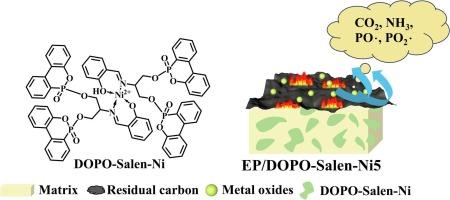Novel organic-metal hybrid coordination complex constituted by DOPO and Salen-Ni for enhancing flame retardancy of epoxy resins
IF 6.3
2区 化学
Q1 POLYMER SCIENCE
引用次数: 0
Abstract
Frequent fire accidents underscore the urgent challenge for improving the flame retardancy of epoxy resins (EP). Herein, a multi-level synergistic flame retardant (DOPO-Salen-Ni) was constructed via 9,10-dihydro9-oxa-10-phosphaphenanthrene-10-oxide (DOPO) and Salen-Ni ligand compounds. Fourier transform infrared spectroscopy and nuclear magnetic resonance spectroscopy confirmed the structure of DOPO-Salen-Ni. Doped DOPO-Salen-Ni improved flexural strength and modulus of EP composites. Limiting oxygen index (LOI) of EP doped 5 wt% DOPO-Salen-Ni (EP/DOPO-Salen-Ni5) was raised to 32.2 % compared with pure EP (25.8 %), achieved UL-94 V0 level. The peak heat release rate, total heat release and total smoke production were reduced by 28.2 %, 26.1 % and 27.1 % compared with pristine EP. DOPO-Salen-Ni enhanced the flame retardant properties of EP through the synergistic mechanism between gas phase and condensed phase. This novel organic–inorganic design strategy offers great potential for flame retardant design.

由DOPO和Salen-Ni组成的新型有机-金属杂化配合物增强环氧树脂的阻燃性
火灾事故频发,提高环氧树脂(EP)的阻燃性迫在眉睫。通过9,10-二氢9-氧-10-磷菲-10-氧化物(DOPO)和Salen-Ni配体化合物构建了多级协同阻燃剂DOPO-Salen-Ni。傅里叶变换红外光谱和核磁共振光谱证实了DOPO-Salen-Ni的结构。掺杂DOPO-Salen-Ni提高了EP复合材料的抗弯强度和模量。与纯EP(25.8%)相比,掺杂5 wt% DOPO-Salen-Ni的EP (EP/DOPO-Salen-Ni5)的极限氧指数(LOI)提高到32.2%,达到UL-94 V0水平。与原始EP相比,峰值放热率、总放热率和总产烟量分别降低了28.2%、26.1%和27.1%。DOPO-Salen-Ni通过气相和凝聚相的协同作用增强EP的阻燃性能。这种新型的有机-无机设计策略为阻燃剂设计提供了巨大的潜力。
本文章由计算机程序翻译,如有差异,请以英文原文为准。
求助全文
约1分钟内获得全文
求助全文
来源期刊

European Polymer Journal
化学-高分子科学
CiteScore
9.90
自引率
10.00%
发文量
691
审稿时长
23 days
期刊介绍:
European Polymer Journal is dedicated to publishing work on fundamental and applied polymer chemistry and macromolecular materials. The journal covers all aspects of polymer synthesis, including polymerization mechanisms and chemical functional transformations, with a focus on novel polymers and the relationships between molecular structure and polymer properties. In addition, we welcome submissions on bio-based or renewable polymers, stimuli-responsive systems and polymer bio-hybrids. European Polymer Journal also publishes research on the biomedical application of polymers, including drug delivery and regenerative medicine. The main scope is covered but not limited to the following core research areas:
Polymer synthesis and functionalization
• Novel synthetic routes for polymerization, functional modification, controlled/living polymerization and precision polymers.
Stimuli-responsive polymers
• Including shape memory and self-healing polymers.
Supramolecular polymers and self-assembly
• Molecular recognition and higher order polymer structures.
Renewable and sustainable polymers
• Bio-based, biodegradable and anti-microbial polymers and polymeric bio-nanocomposites.
Polymers at interfaces and surfaces
• Chemistry and engineering of surfaces with biological relevance, including patterning, antifouling polymers and polymers for membrane applications.
Biomedical applications and nanomedicine
• Polymers for regenerative medicine, drug delivery molecular release and gene therapy
The scope of European Polymer Journal no longer includes Polymer Physics.
 求助内容:
求助内容: 应助结果提醒方式:
应助结果提醒方式:


